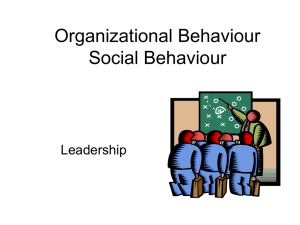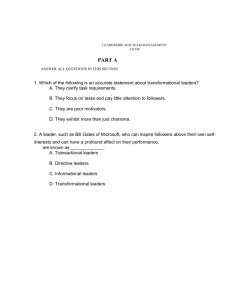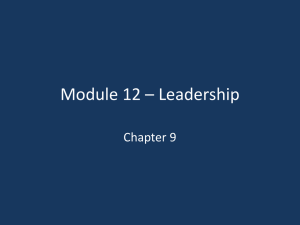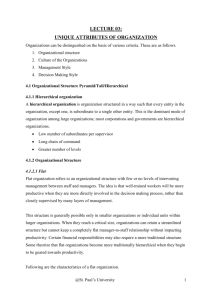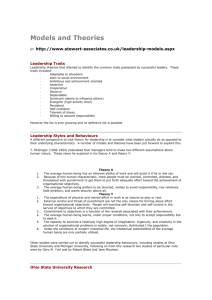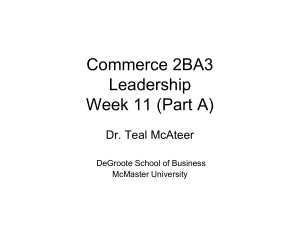OB Ch. 9
advertisement
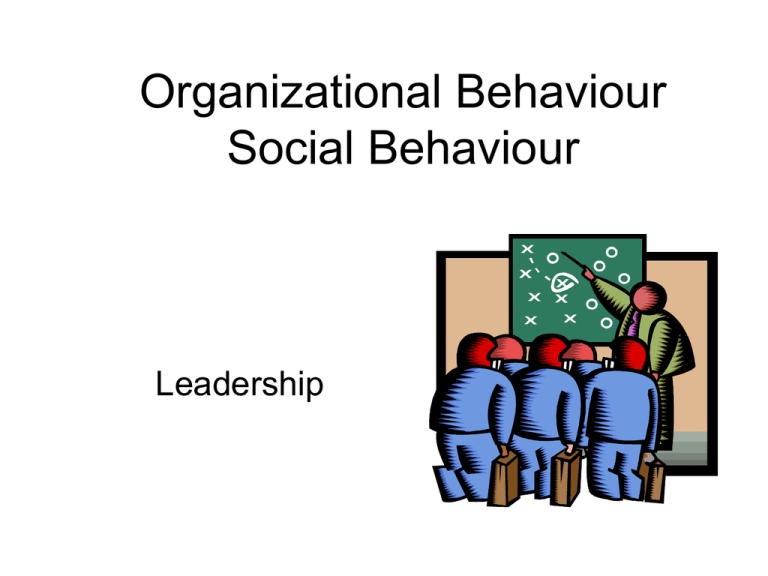
Organizational Behaviour Social Behaviour Leadership Defining Leadership • The use of influence to achieve goals The trait perspective of leadership – The Great Man approach • Traits = distinguishing personal characteristics that are generally not mutable (changeable) – Weak but consistent support for a variety of leadership traits Self-confidence Honesty/Integrity Energy Need for achievement Intelligence Dominance Emotional stability Motivation to lead Ohio State studies of leadership • Two key dimensions were related to leadership – Consideration – the extent to which the leader is approachable and shows personal concern for subordinates and – Initiating structure – the extent to which the leader is task oriented and directs the group toward goal attainment Situational approaches: Fiedler’s Contingency Theory • Leader motivation – Relationship oriented - high LPC score – Task oriented - low LPC score Situational approaches: Fiedler’s Contingency Theory • Situational conditions – Leader-member relations – favourable when there is support, trust, and cooperation – Task structure – favourable when there is high task structure: clear goals, procedures, and objective measures of performance – Position power – favourable when supported by the organization hierarchy Fiedler’s Contingency Theory Favourableness Leader-member relations High Low Good Poor Task structure Structured Unstructured Structured Unstructured Position power Effective leader orientation Strong Weak Strong Weak Strong Weak Strong Weak I II III IV V VI VII VIII Task Relationship Task Situational approaches: Path-Goal Theory • Leader behaviour types 1. Directive behaviour – schedules work, sets performance standards, gives direction 2. Supportive behaviour – friendly, approachable, expresses concern 3. Participative behaviour – uses consultative processes, shares work problems, considers suggestions 4. Achievement oriented – demanding and supportive, seeks continual improvement Path-Goal Theory • Subordinate characteristics – Locus of control – Self-confidence - subordinate perception of their abilities – skills and experience • Situational characteristics – Task structure– clear and routine versus challenging and ambiguous – Team dynamics - work group norms and influence Situational approaches: Participative Models • Purpose: – To motivate – increases enrichment and autonomy – To create quality – adds more information into the problem solving – To increase acceptance of the decision – in issues of fairness or change Participative Models • Downsides – Time and energy – involves a slower process and less experienced participants – Lack or receptivity or knowledge – not everyone is interested or skilled enough – Organizational climate or leader attributes – the organization or leader may not be predisposed to use participatory methods Situational Leadership Theory • Leader behaviour types – Task behaviour – spells out responsibilities and tells people what to do (like initiating structure) – Relationship behaviour – listening, giving social emotional support (like consideration) • Follower maturity/ task readiness – Job maturity – task relevant knowledge, experience, and skill – Psychological maturity – self-confidence, commitment, and motivation Situational Leadership Theory • Four leadership styles: 1. 2. 3. 4. Telling – very directive, giving explicit direction (high task, low relationship behaviour) Selling – leader provides direction, uses persuasion to reduce resistance, may seek input (high task, high relationship behaviour) Participating (consulting) – focus on growth and improvement through guidance, communication, and opportunities for subordinate decision making (low task, high relationship behaviour) Delegating (join) – little direction or support, subordinates assume responsibility and are believed to be fully capable (low task, low relationship behaviour) Contingency approach: Situational Leadership Theory Relationship behaviors Participating (Lo T; Hi R) Delegating (Lo T; Lo R) Selling (Hi T; Hi R) Telling (Hi T; Lo R) Task behaviors High follower M4 -Able and willing maturity M3 - Able M2 – but unwilling Unable but or insecure willing M1 –Unable and unwilling or insecure Low follower maturity Situational Approaches: Participative Leadership • Three key considerations: 1. Quality requirement – can the decision turn out badly; are all options equal in quality 2. Commitment/Acceptance decision - will employees be committed enough to the decision to implement it properly 3. Time availability – how efficiently must the decision be made leader participation contingency variables • QR Quality Requirement–is the technical quality of this decision important • LI Leader information – does the leader have sufficient information to create a high quality decision • ST Problem Structure – is the problem well structured • CR (AR) Commitment/Acceptance Requirement- is subordinate commitment to the decision important • CP (AP) Commitment/Acceptance Probability – if you made the decision yourself, is it reasonably certain that subordinates would be committed to the decision information leader participation contingency variables • GC Goal Congruence – Do subordinates share the organizational goals to be attained by solving this problem • CO Subordinate Conflict – Is conflict among subordinates likely in the preferred solution • SI Subordinate Information – Do subordinates have sufficient information to make a high quality decision leader participation contingency variables • Added considerations: TC Time Constraint – Is there a time constraint that limits your ability to involve subordinates MD Motivation Development – Is it important to maximize the opportunities for subordinate development Participative Leadership • Issues: – Not all subordinates are equally skilled or interested – Not all managers are equally skilled or interested – Not all organizational cultures support flexible decision styles Transactional Leaders • Power is derived through the ability to reward and punish • Clear and define the pathway so that followers know what is expected • Take into consideration followers needs Transformational leaders • Influence comes from follower acceptance of values and vision which guide all decisions and behaviours • Transformational Leaders: – Intellectually stimulate followers – Give individualized consideration – Are charismatic Neutralizers of leadership People oriented leadership -Knowledgeable, experienced subordinates -Subordinates with high need for independence -”Professional” subordinates -Subordinates indifferent to organizational rewards -Subordinates doing routine or standardized work -Task has built in feedback -Task is intrinsically satisfying -Organization is highly formalized (written rules) -Work group is cohesive -Rewards cannot be affected by the supervisor -Large distance between supervisor and subordinate x x x Task oriented leadership x x x x x x x x x x x x x x Does leadership make a difference • Leader irrelevance – Situational importance – The “romance of leadership” • Attributing leadership • Stereotyping leadership • Need for situational control
